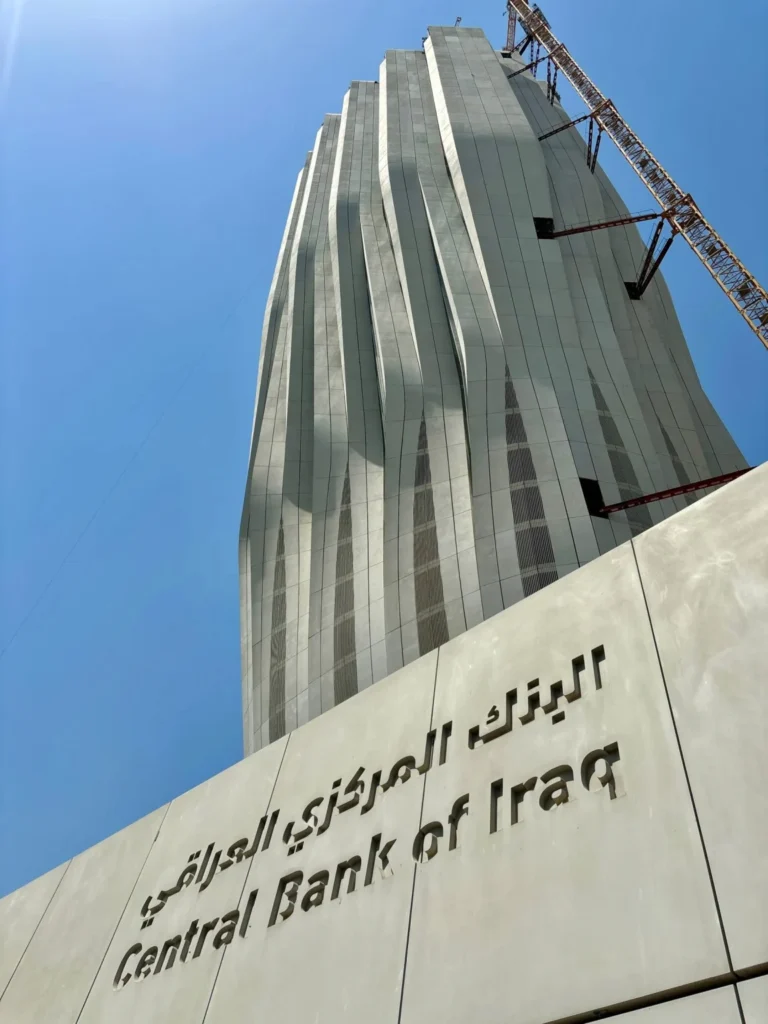The Central Bank of Iraq, designed by Zaha Hadid Architects, is nearing completion and is now the tallest building in Baghdad. Located along the Tigris River, the 170-meter-tall skyscraper features a distinctive twisting facade that reflects the river’s movement. The building is designed to maximise natural light and provide impressive city views.
Commissioned in 2010, the Central Bank of Iraq represents a major advancement in Iraq’s architecture. Combining modern design with cultural respect, it symbolizes the country’s resilience and commitment to progress. Its completion will mark a new era in Baghdad’s development.

Innovative Design of the Skyscraper
The Central Bank of Iraq, designed by Zaha Hadid Architects, features several standout elements that contribute to its distinctive character. Here are the unique features of this building:
- Twisting Exoskeleton Frame: The building features a twisting exoskeleton frame that supports the structure and gives it a modern look.
- Rippling Facade: The exoskeleton’s rippled design reflects the light from the Tigris River and shades the building’s windows.
- Grand Atrium: A spacious atrium brings natural light inside and offers views of the river.
- Landscaped Podium: The podium includes terraces and gardens, blending the building with its surroundings.
- Dynamic Building Form: The structure starts narrow, expands in the middle, and narrows again at the top, providing stability and visual interest.
- Open Floor Plans: The design allows for large, flexible interior spaces with minimal internal columns.
Special Exoskeleton frame used for the building design
What is an exoskeleton frame?
An exoskeleton frame is an outer structure that supports the building and shapes its look. It carries the load of the building, allowing for open and flexible interiors without many internal supports.
In the case of the Central Bank of Iraq, the twisting exoskeleton frame not only enhances the building’s structural integrity but also contributes to its distinctive appearance.
Advantages:
- Load Distribution: Spreads weight across the outside, reducing the need for inside columns.
- Enhanced Stability: Makes the building more stable and resistant to wind and earthquakes.
- Flexible Interiors: Allows for open interior spaces without internal walls.
- Dynamic Performance: Supports complex designs and adapts to environmental conditions.
- Thermal Performance: Helps with energy efficiency by managing heat better.

The use of glass in design
By utilizing advanced glazing technologies, the building benefits in several key ways:
- Extensive glazing allows abundant natural light, reducing the need for artificial lighting and creating a brighter, more welcoming environment.
- High-performance glass with low-emissivity coatings and insulating properties reduces overall energy consumption.
Interior of the Building
The building’s interior features a grand atrium that draws natural light deep into the building. Spanning 90,000 square meters, the building accommodates office spaces, meeting rooms, and essential facilities.It also offers beautiful views of the city and the Tigris River, linking the interior to its surroundings.
Construction Challenges and Innovations
The construction of the Central Bank of Iraq faced challenges due to its unique design. The twisting exoskeleton required precise engineering and advanced material to ensure structural stability.
Challenges:
- Complex Design: The twisting exoskeleton required precise engineering to maintain structural stability.
- Material Requirements: Development of new materials to meet the design’s ambitious specifications.

Innovations:
- Advanced Concrete Technology: High-strength concrete was used for the exoskeleton to provide support and enhance its appearance.
- Engineered Finishes: Concrete was specially engineered to improve finishes and performance, contributing to shading and energy management.
Conclusion
The Central Bank of Iraq, designed by Zaha Hadid Architects, seamlessly combines advanced technologies with thoughtful design, establishing a new benchmark for modern architecture that respects historical and cultural contexts. As it nears completion, the building stands out as a contemporary landmark for the city of Baghdad.


